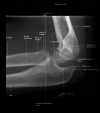A think-aloud study to inform the design of radiograph interpretation practice
- PMID: 32140874
- PMCID: PMC7471179
- DOI: 10.1007/s10459-020-09963-0
A think-aloud study to inform the design of radiograph interpretation practice
Abstract
Models for diagnostic reasoning in radiology have been based on the observed behaviors of experienced radiologists but have not directly focused on the thought processes of novices as they improve their accuracy of image interpretation. By collecting think-aloud verbal reports, the current study was designed to investigate differences in specific thought processes between medical students (novices) as they learn and radiologists (experts), so that we can better design future instructional environments. Seven medical students and four physicians with radiology training were asked to interpret and diagnose pediatric elbow radiographs where fracture is suspected. After reporting their diagnosis of a case, they were given immediate feedback. Participants were asked to verbalize their thoughts while completing the diagnosis and while they reflected on the provided feedback. The protocol analysis of their verbalizations showed that participants used some combination of four processes to interpret the case: gestalt interpretation, purposeful search, rule application, and reasoning from a prior case. All types of processes except reasoning from a prior case were applied significantly more frequently by experts. Further, gestalt interpretation was used with higher frequency in abnormal cases while purposeful search was used more often for normal cases. Our assessment of processes could help guide the design of instructional environments with well-curated image banks and analytics to facilitate the novice's journey to expertise in image interpretation.
Keywords: Cognition; Education (medical); Emergency medicine; Instructional design; Radiology.
Figures




References
-
- American Educational Research Association, American Psychological Association, Joint Committee on Standards for Educational, Psychological Testing (US), & National Council on Measurement in Education. (1985). Standards for educational and psychological testing. American Educational Research Association.
-
- Azevedo, R., Faremo, S., & Lajoie, S. P. (2007). Expert-novice differences in mammogram interpretation. In Proceedings of the annual meeting of the cognitive science society (Vol. 29, No. 29).
-
- Beckstead JW, Boutis K, Pecaric M, Pusic MV. Sequential dependencies in categorical judgments of radiographic images. Advances in Health Sciences Education. 2017;22(1):197–207. - PubMed
-
- Boutis K, Pecaric M, Carrière B, Stimec J, Willan A, Chan J, Pusic M. The effect of testing and feedback on the forgetting curves for radiograph interpretation skills. Medical Teacher. 2019;41(7):756–764. - PubMed
Publication types
MeSH terms
LinkOut - more resources
Full Text Sources

